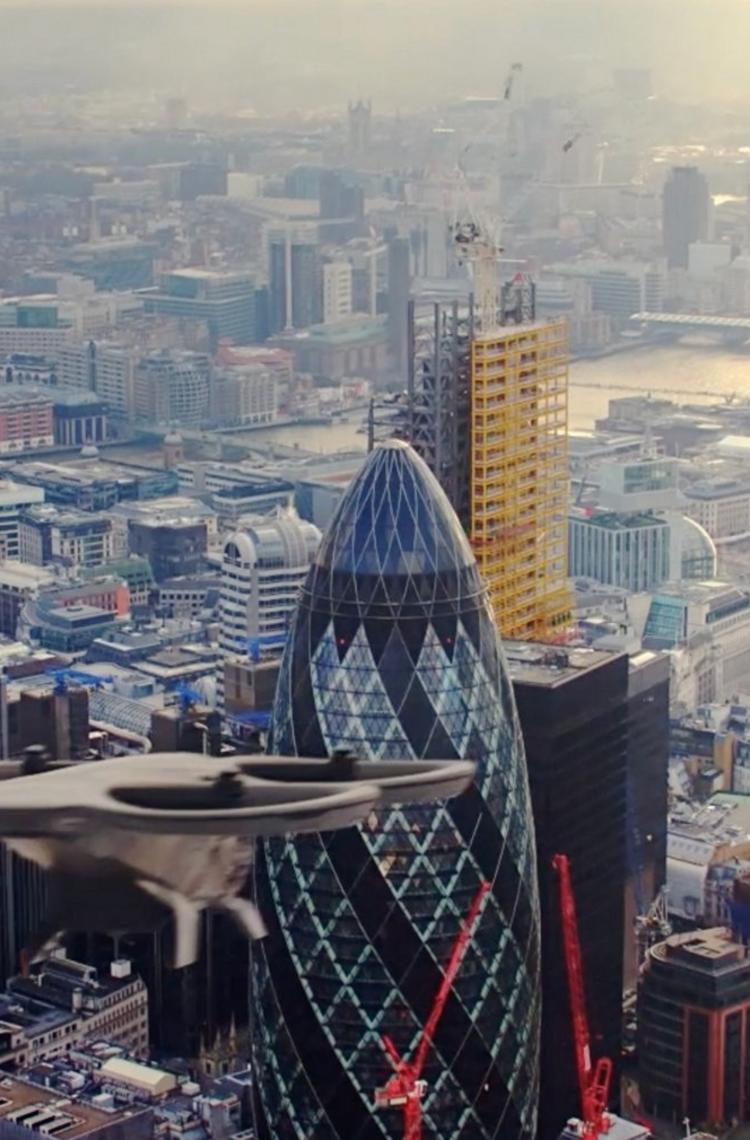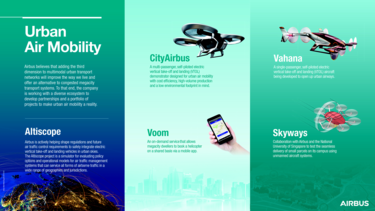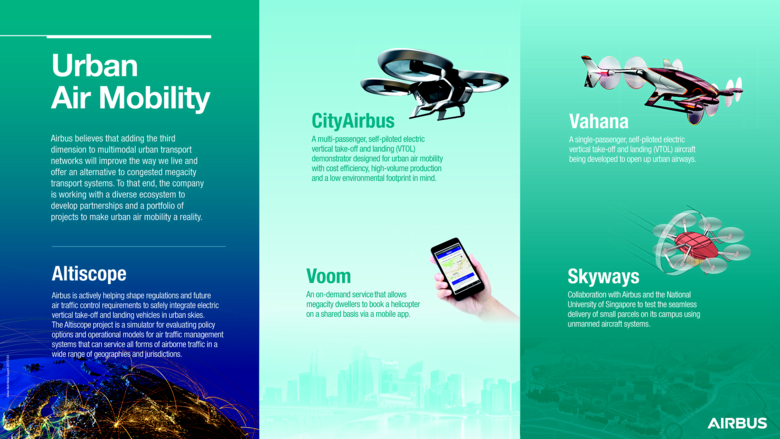With the establishment of its new Urban Air Mobility unit, Airbus aims to lay the foundations for more efficient and sustainable city travel. To co-create an entire industry from scratch, it will develop cutting-edge technical solutions as well as engage a wide range of stakeholders to ensure maximum societal benefit.
Joerg Mueller recently experienced just how easy urban travel can be. After landing at the airport in São Paulo, Brazil, he used Airbus’ on-demand helicopter booking platform, Voom, to take him directly to his hotel. “In rush hour traffic, that journey can take two hours,” says the Head of Programmes and Strategy for Urban Air Mobility (UAM). “It took me just 11 minutes of flight time.”
Voom is currently operating in São Paulo and Mexico City, and the demand is already impressive.
"Thousands of passengers have used the service and many of them were flying in a helicopter for the first time," says Voom CEO Clement Monnet.
The service will be launched in other megacities in 2019 and beyond and will continue to lay the groundwork for Airbus’ longer-term vision of urban mobility using electric vertical take-off and landing (eVTOL) vehicles. “Voom has proven to be an awesome mechanism for us to glean key insights into the potential of the on-demand air mobility market and passenger preferences, and we are constantly relaying those insights to the UAM team,” says Monnet.
Realising that future vision is the task of Airbus’ new UAM unit, established in June 2018. Voom is just one part of the unit, which hosts the ongoing UAM activities across the company, from air traffic management to infrastructure development, including partnership building and pilot projects. It also steers the development of Airbus’ ongoing eVTOL demonstrators, Vahana and CityAirbus.
Airbus Urban Mobility
A new era of aviation safely, efficiently and fairly.
Cities have been trying to fine-tune these systems to alleviate the issues, but without major changes, the scope is limited.
- Vincent Loubière, Airbus’ Director of City Integration and Infrastructure Development for UAM
Understanding cities
A key responsibility for the new unit is understanding how UAM can introduce an added mobility solution to a city’s existing network for the benefit of its citizens. By gathering urban flow data from cities like Paris or Beijing and using advanced modelling software, Vincent Loubière - Airbus’ Director of City Integration and Infrastructure Development for UAM- and his team of designers, urbanists, architects and sociologists can simulate and understand how people move around to develop sustainable urban development strategies.
“Not only have cities become more densely populated in recent decades, they have also become increasingly centralised as more people travel to, from and around a central point,” says Loubière. This is putting a tremendous strain on ground transportation. "Cities have been trying to fine-tune these systems to alleviate the issues, but without major changes, the scope is limited."
Urban air mobility could bring an entirely new dimension to the way we live and, in the process, reshape city planning. By experimenting with virtual models, Loubière and his colleagues are beginning to design convenient, sustainable systems that could seamlessly integrate into an existing city infrastructure.
Of course, some new elements will be required, which is why the team is looking at different types of ‘vertiports’ – an airport for VTOL vehicles. This could range from a single landing pad on top of a building to a larger system of multiple landing pads that could redefine the purpose and function of motorways.
Our team is carrying out projects across the public and private sector, and evaluating, for example, how all these different types of flying vehicles might interact sharing the same airspace.
- Isabel Del Pozo, Airbus Head of Airspace Management
Redefining traffic management
Beyond working out infrastructure requirements, the unit, through Isabel Del Pozo, Head of Airspace Management, is exploring solutions that will ensure this new era of flight operates safely and efficiently in the urban airspace.
“The existing air traffic management system is tailored to commercial flights for fixed-wing aircraft. It still relies on voice communication and human-centred task execution,” she says. “We’re already close to exceeding its capacity, and that’s just for manned flights. When we introduce autonomous vehicles during the next decade, traffic will increase considerably.”
Del Pozo wants to create more intelligent, autonomous and decentralised traffic management solutions that support operations in urban areas, from helicopters to drones. This will gradually pave the way for autonomous eVTOLs carrying passengers.
A key element is unmanned traffic management (UTM). For almost two years, the Altiscope project in A³ has been working with regulators and key stakeholders to define a clear picture of the future of traffic management, publishing the Airbus UTM roadmap called Blueprint for the Sky and becoming a Federal Aviation Administration Low Altitude Authorization and Notification Capability (LAANC) certified service provider. In December 2018, the Altiscope team transitioned from A³ into the UAM unit to form Airbus UTM.
“This vision laid out by Blueprint will guide our work for years to come,” says del Pozo. “Our team is carrying out projects across the public and private sector, and evaluating, for example, how all these different types of flying vehicles might interact sharing the same airspace.”
Well placed for success
Airbus isn’t the only company looking to tap into the potential of urban air mobility. Joerg Mueller says there are now more than 100 different electric VTOL vehicles under development by ambitious start-ups and established global names.
“But Airbus has been building and certifying flying platforms to the highest levels of safety for decades. In some ways, building the vehicle for this market is the easier part,” he says. “Given our credibility with authorities, passengers, potential partners, and our longstanding aerospace expertise, we are ideally positioned to bring disruptive end-to-end mobility solutions to the market.”
Co-creating with citizens
To create an entirely new industry, dialogues and alliances across sectors are crucial, as is the active engagement of communities. In 2017, Airbus was appointed to lead the European Commission’s UAM Initiative, which is part of the wider European Innovation Partnership on Smart Cities and Communities (EIP-SCC).
Managing the initiative is Vassilis Agouridas, Senior Manager Strategic Innovation at Airbus. "Our aim is to mobilise cities and regions across Europe along with a wide ecosystem of stakeholders interested in launching practical mobility demonstration projects with ground and air mobility" "Airbus will act as the orchestrator and catalyst for a European community of urban air mobility.”
There are currently 17 European cities on-board, with 12 projects under definition, ranging from an exploration of air taxi and drone ambulance use to how drones might benefit logistics hub or emergency services.
Urban air mobility is much more than technical solutions, though – public acceptance is fundamental. “By planning the active involvement of citizens to become co-creators of future mobility solutions, we are aiming to shape the third dimension of mobility in a sustainable and socially acceptable manner,” Agouridas says. “This is in addition to the initial involvement and support of political, regulatory and civil aviation authorities, as well as other institutional transport organisations. Ultimately, this is about our lives, how we move.”
Our aim is to mobilise cities and regions across Europe along with a wide ecosystem of stakeholders interested in launching practical mobility demonstration projects with ground and air mobility
- Vassilis Agouridas, Senior Manager Strategic Innovation at Airbus
“It’s been eye-opening”
Three questions for Eduardo Dominguez Puerta – Head of Urban Air Mobility
What have you been focusing on in the first few months of the UAM unit?
First of all, I have to say that the UAM team is an amazing set of talented individuals from across the company with a genuine drive to make a difference through our activities – it’s inspiring! My initial focus these last few months has been to align our various projects to a common strategy and set the right tempo. We are currently developing and testing our existing vehicle demonstrators, which will allow us to define a path for the future generation of vehicles. We’ve consolidated all company-wide activities related to traffic management, are continuing to expand Voom, and are also very active in strengthening contacts with cities and partners.
Have there been any major surprises?
It’s been eye-opening to see just how important it is to engage as early as possible with political authorities, cities, regulators and citizens. We tend to focus on the technologies, but sometimes we underestimate the importance of social policies, civil leadership, and those whom these technologies will ultimately benefit.
How would you define success in the short- to medium-term?
We’re moving ahead full speed to continue developing the technologies that we need to realise our vision with UAM, while engaging with a wide range of stakeholders to ensure we deliver a mobility system that provides minimal environment impact and maximum societal benefit. Let’s be clear: we’re co-creating an entire industry from scratch! That’s much bigger than vehicle technologies and any single company.
We are co-creating an entire industry from scratch.
- Eduardo Dominguez Puerta, Head of Urban Air Mobility


